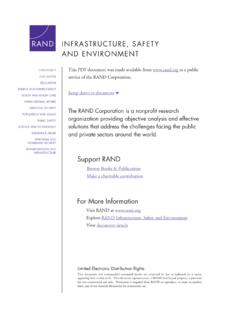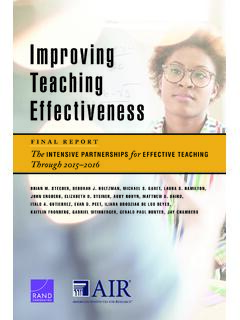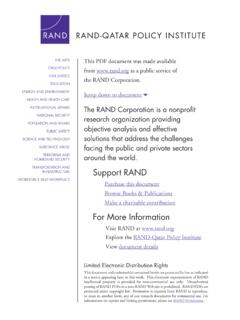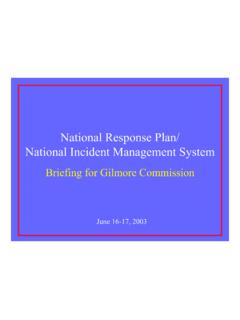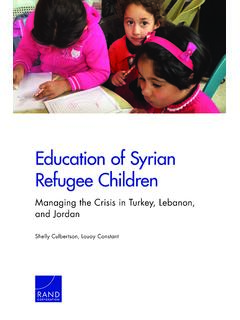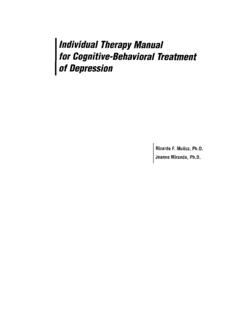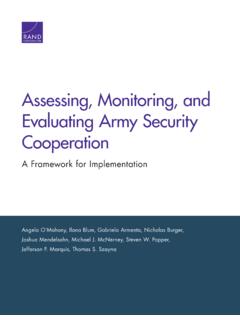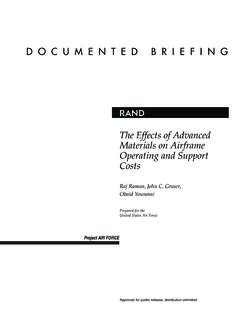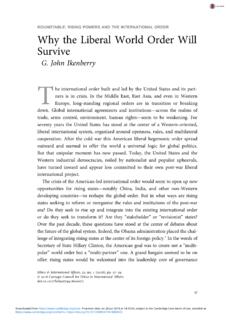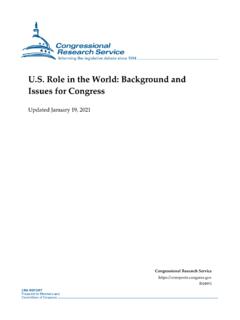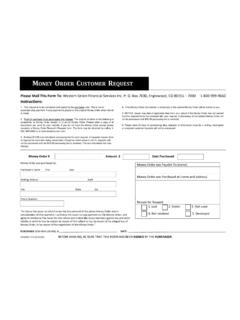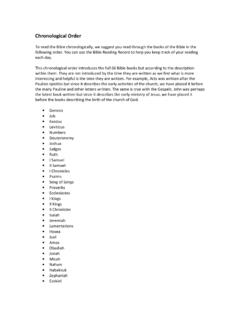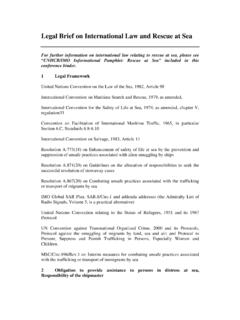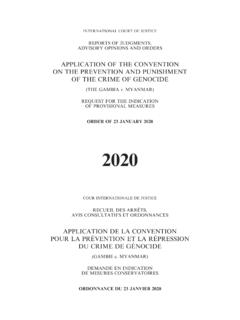Transcription of Understanding the Current International Order
1 CORPORATIONUNDERSTANDINGTHEM ichael J. MazarrMiranda PriebeAndrew RadinAstrid Stuth CevallosBUILDING A SUSTAINABLE International ORDERA RAND Project to Explore Strategy in a Changing WorldCurrent International OrderLimited Print and Electronic Distribution RightsThis document and trademark(s) contained herein are protected by law. This representation of RAND intellectual property is provided for noncommercial use only. Unauthorized posting of this publication online is prohibited. Permission is given to duplicate this document for personal use only, as long as it is unaltered and complete.
2 Permission is required from RAND to reproduce, or reuse in another form, any of its research documents for commercial use. For information on reprint and linking permissions, please visit RAND Corporation is a research organization that develops solutions to public policy challenges to help make communities throughout the world safer and more secure, healthier and more prosperous. RAND is nonprofit, nonpartisan, and committed to the public interest. RAND s publications do not necessarily reflect the opinions of its research clients and RANDMake a tax-deductible charitable contribution at of Congress Cataloging-in-Publication Data is available for this : 978-0-8330-9570-1 For more information on this publication, visit by the RAND Corporation, Santa Monica, Calif.
3 Copyright 2016 RAND CorporationR is a registered design by Dori 1945, the United States has pursued its global interests through creating and maintaining International economic institutions, bilateral and regional security organizations, and liberal political norms; these ordering mechanisms are often collectively referred to as the interna-tional Order . In recent years, rising powers have begun to challenge aspects of this Order . This report is part of a project, titled Building a Sustainable International Order , that aims to understand the existing International Order , assess Current challenges to the Order , and recom-mend future policies with respect to the Order .
4 The study will produce multiple reports and essays. Three are cen-tral to the study s assessment of the International Order : One report defines and scopes the Order ; one examines its status, attempting to create measurable indexes of the Order s health; and one examines the perspectives of major countries toward the Order . This report is the first of those and reflects the project team s attempt to understand the existing International Order , including how decisionmakers have described and used the Order in conducting foreign policy.
5 As well as how academics have assessed the mechanisms by which the Order affects state research was sponsored by the Office of the Secretary of Defense s Office of Net Assessment and conducted within the Inter-national Security and Defense Policy Center of the R AND National Defense Research Institute, a federally funded research and develop-ment center sponsored by the Office of the Secretary of Defense, the iv Understanding the Current International OrderJoint Staff, the Unified Combatant Commands, the Navy, the Marine Corps, the defense agencies, and the defense Intelligence more information on the R AND International Security and Defense Policy Center, see or contact the director (contact information is provided on the web page).
6 VContentsPreface ..iiiFigures and Table ..viiSummary ..ixAcknowledgments ..xiiiAbbreviations ..xvCHAPTER ONEThe Role of International Order in Strategy ..1 Risks to the Current Order ..2 Roadmap and Methodology ..4 CHAPTER T WO Defining the International Order ..7 The Post World War II, Rules-Based Liberal Order ..12 The Order s Purposes and Its Effects ..23 Conclusion and Policy Implications ..26 CHAPTER THREEE ngines of International Order ..31 Rational Pursuit of Common Interests ..32 Interests of a Hegemonic Power.
7 35 Domestic Politics ..36 Socialization and Constructed Identities ..37 Systemic Effects ..39 Conclusion and Policy Implications ..41vi Understanding the Current International OrderCHAPTER Approach to the International Order .. Visions of the International Order ..43 The International Order in National Security Strategy Documents .. Interests and Approaches to the International Order ..52 Conclusion and Policy Implications ..54 CHAPTER FIVEI mplications for a Research Agenda ..57 References ..59viiFigures and TableFigures Schematic Understanding of the Role of International Order .
8 9 Elements and Engines of the Liberal International Order ..14 International Order , 1980 ..18 Role of Causal Mechanisms ..32 Table Alternative Conceptions of Order ..25ixSummarySince 1945, the United States has pursued its global interests through creating and maintaining International economic institutions, bilateral and regional security organizations, and liberal political norms; these ordering mechanisms are often collectively referred to as the interna-tional Order . In recent years, rising powers have begun to challenge aspects of this Order .
9 This report is part of a project, titled Build-ing a Sustainable International Order , that aims to understand the existing International Order , assess Current challenges to the Order , and recommend future policies with respect to the Order . The report reflects the project team s attempt to understand the existing interna-tional Order , including how decisionmakers have described and used the Order in conducting foreign policy, as well as how academics have assessed the mechanisms by which the Order affects state primary reason that we and others are focusing attention on the International Order today is because it is perceived to be at risk and, by extension, interests served by the Order might also be at risk.
10 An analysis of the character of the post World War II Order points to three broad categories of possible risk: 1. some leading states that see many components of the Order as designed to constrain their power and perpetuate hege-mony2. volatility from failed states or economic crises3. shifting domestic politics in an era of slow growth and growing i nequ a l it y. x Understanding the Current International OrderThe Order s legitimacy rests on states believing that participation in the Order benefits them directly, and this belief is being shaken by various economic and social trends.
